Rock Magnetism of Lapilli and Lava Flows from Cumbre Vieja Volcano, 2021 Eruption (La Palma, Canary Islands): Initial Reports
Abstract
1. Introduction
2. Geological Setting and Microscopic Observations
3. Samples and Methods
4. Results
4.1. Bulk Susceptibility
4.2. Thermomagnetic Curves
4.3. IRM Acquisition and Component Analysis
4.4. Hysteresis Curves
5. Final Remarks
Author Contributions
Funding
Institutional Review Board Statement
Informed Consent Statement
Data Availability Statement
Acknowledgments
Conflicts of Interest
References
- Carracedo, J.C.; Troll, V.R.; Day, J.M.D.; Geiger, H.; Aulinas Junca, M.; Soler, V.; Deegan, F.M.; Perez-Torrado, F.J.; Gisbert Pinto, G.; Gazel, E.; et al. The 2021 eruption of the Cumbre Vieja Volcanic Ridge on La Palma, Canary Islands. Geol. Today 2022, 38, 94–107. [Google Scholar] [CrossRef]
- Hernandez-Pacheco, A.; Valls, M. The historic eruptions of La Palma island (Canaries). Arquipélago Série Ciências da Natureza 1982, 3, 83–94. [Google Scholar]
- Buddington, A.F.; Lindsley, D.H. Iron-titanium oxide minerals and synthetic equivalents. J. Pet. 1964, 5, 310–357. [Google Scholar] [CrossRef]
- Calvo, M.; Prévot, M.; Perrin, M.; Riisager, J. Investigating the reasons for the failure of paleointensity experiments: A study on historical lava flows from Mt. Etna. Geophys. J. Int. 2002, 149, 44–63. [Google Scholar] [CrossRef]
- Furukawa, K.; Uno, K.; Miyagi, I. Mechanisms of oxidation and degassing in the Takanoobane rhyolite lava of Aso Volcano, Japan. J. Volcanol. Geotherm. Res. 2010, 198, 348–354. [Google Scholar] [CrossRef]
- Goguitchaichvili, A.; Conte, G.; Urrutia-Fucugauchi, J.; Alva-Valdivia, L.; Morales, J.; González-Morán, T. Microwave paleointensity analysis of historic lavas from Paricutín volcano, Mexico. Geofísica Int. 2005, 44, 231–240. [Google Scholar] [CrossRef]
- Lerner, P.G.A.; Piispa, E.J.; Bowles, J.A.; Ort, M.H. Paleomagnetism and rock magnetism as tools for volcanology. Bull. Volcanol. 2022, 84, 24. [Google Scholar] [CrossRef]
- Saito, T.; Ishikawa, N. Pre- and syn-eruptive conditions inferred from the magnetic petrology of Fe–Ti oxides from three historical eruptions of Unzen Volcano, Japan. J. Volcanol. Geotherm. Res. 2012, 247–248, 49–61. [Google Scholar] [CrossRef]
- Saito, T.; Ishikawa, N.; Kamata, H. Magnetic petrology of the 1991–1995 dacite lava of Unzen volcano, Japan: Degree of oxidation and implications for the growth of lava domes. J. Volcanol. Geotherm. Res. 2007, 164, 268–283. [Google Scholar] [CrossRef]
- Tucker, P.; O’Reilly, W. The laboratory simulation of deuteric oxidation of titanomagnetites: Effect on magnetic properties and stability of thermoremanence. Phys. Earth Planet. Inter. 1980, 23, 112–133. [Google Scholar] [CrossRef]
- Vahle, C.; Kontny, A.; Gunnlaugsson, H.P.; Kristjansson, L. The Stardalur magnetic anomaly revisited—New insights into a complex cooling and alteration history. Phys. Earth Planet. Inter. 2007, 164, 119–141. [Google Scholar] [CrossRef][Green Version]
- Valet, J.-P.; Soler, V. Magnetic anomalies of lava fields in the Canary islands. Possible consequences for paleomagnetic records. Phys. Earth Planet. Inter. 1999, 115, 109–118. [Google Scholar] [CrossRef]
- Dunlop, D.; Özdemir, Ö. Rock Magnetism: Fundamentals and Frontiers; Cambridge Studies in Magnetism; Cambridge University Press: Cambridge, UK, 1997. [Google Scholar] [CrossRef]
- Anguita, F.; Hernán, F. The Canary Islands origin: A unifying model. J. Volcanol. Geotherm. Res. 2000, 103, 1–26. [Google Scholar] [CrossRef]
- Carracedo, J.C. The Canary Islands: An example of structural control on the growth of large oceanic island volcanoes. J. Volcanol. Geoth. Res. 1994, 60, 225–242. [Google Scholar] [CrossRef]
- Ancochea, A.; Hernán, F.; Cendrero, A.; Cantagrel, J.M.; Fúster, J.M.; Ibarrola, E.; Coello, J. Constructive and destructive episodes in the building of a young oceanic island, La Palma, Canary Islands, and genesis of the Caldera de Taburiente. J. Volcanol. Geotherm. Res. 1994, 60, 243–262. [Google Scholar] [CrossRef]
- Carracedo, J.C.; Day, S.J.; Guillou, H.; Gravestock, P. Later stages of volcanic evolution of La Palma, Canary Islands: Rift evolution, giant landslides, and the genesis of the Caldera de Taburiente. Geol. Soc. Am. Bull. 1999, 111, 755–768. [Google Scholar] [CrossRef]
- Klügel, A.; Galipp, K.; Hoernie, K.; Hauff, F.; Groom, S. Geochemical and volcanological evolution of La Palma, Canary Islands. J. Petrol. 2017, 58, 1227–1248. [Google Scholar] [CrossRef]
- Pankhurst, M.J.; Scarrow, J.H.; Barbee, O.A.; Hickey, J.; Coldwell, B.C.; Rollinson, G.K.; Rodríguez-Losada, J.A.; Martín Lorenzo, A.; Rodríguez, F.; Hernández, W.; et al. Rapid response petrology for the opening eruptive phase of the 2021 Cumbre Vieja eruption, La Palma, Canary Islands. Volcanica 2022, 5, 1–10. [Google Scholar] [CrossRef]
- Harrison, R.J.; Feinberg, J.M. FORCinel: An improved algorithm for calculating first-order reversal curve distributions using locally weighted regression smoothing, Geochem. Geophys. Geosyst. 2008, 9, Q05016. [Google Scholar] [CrossRef]
- Petrovsky, E. and Kapička. On determination of the Curie point from thermomagnetic curves. J. Geophys. Res. 2006, 111, B12S27. [Google Scholar] [CrossRef]
- Dearing, J.A.; Dann, R.J.L.; Hay, K.; Lees, J.A.; Loveland, P.J.; Maher, B.A.; O’Grady, K. Frequency-dependent susceptibility measurements of environmental materials. Geophys. J. Int. 1996, 124, 228–240. [Google Scholar] [CrossRef]
- Moskowitz, B.M.; Jackson, M.; Kissel, C. Low-temperature magnetic behavior of titanomagnetites. Earth Planet. Sci. Lett. 1998, 157, 141–149. [Google Scholar] [CrossRef]
- Kakol, Z.; Sabol, J.; Stickler, J.; Honig, J.M. Effect of low-level titanium(IV) doping on the resistivity of magnetite near the Verwey transition. Phys. Rev. B 1992, 46, 1975–1978. [Google Scholar] [CrossRef]
- Kakol, Z.; Sabol, J.; Stickler, J.; Kozkowski, A.; Honig, J.M. Influence of titanium doping on the magnetocrystalline anisotropy of magnetite. Phys. Rev. B 1994, 49, 12767–12772. [Google Scholar] [CrossRef] [PubMed]
- Syono, Y. Magnetocrystalline anisotropy and magnetostriction of Fe3O4–Fe2TiO4 series, with special application to rock magnetism. Jpn. J. Geophys. 1965, 4, 71–143. [Google Scholar]
- Senanayake, W.E.; McElhinny, M.W. Hysteresis and susceptibility characteristics of magnetite and titanomagnetites: Interpretation of results from basaltic rocks. Phys. Earth Planet. Inter. 1981, 26, 47–55. [Google Scholar] [CrossRef]
- Tucker, P. Low-temperature magnetic hysteresis properties of multidomain single-crystal titanomagnetite. Earth Planet. Sci. Lett. 1981, 54, 167–172. [Google Scholar] [CrossRef]
- Kakol, Z.; Sabol, J.; Honig, J.M. Magnetic anisotropy of titanomagnetites Fe3−xTixO4, 0 < x < 0.55. Phys. Rev. B 1991, 44, 2198–2204. [Google Scholar] [CrossRef]
- Radhakrishnamurty, C.; Likhite, S.D. Frequency dependence of low-temperature susceptibility peak in some titanomagnetites. Phys. Earth Planet. Inter. 1993, 76, 131–136. [Google Scholar] [CrossRef]
- Morin, F.J. Magnetic susceptibility of α-Fe2O3 and α-Fe2O3 with added titanium. Phys. Rev. 1950, 78, 819–820. [Google Scholar] [CrossRef]
- Safiuddin, L.O.; Haris, V.; Wirman, R.P.; Bijaksana, S. A preliminary study of the magnetic properties on laterite soils as indicators of pedogenic processes. Lat. Lett. 2011, 1, 1–15. [Google Scholar]
- Morrish, A.H. Canted Antiferromagnetism: Hematite; World Scientific: River Edge, NJ, USA, 1994; 192p. [Google Scholar]
- Bowles, J.; Jackson, M.; Banerjee, S. Interpretation of low-temperature data part II: The hematite Morin transition. IRM Q. 2011, 21, 1–7. [Google Scholar]
- Heller, F. Rockmagnetic studies of Upper Jurassic limestones from suthern Germany. J. Geophys. 1978, 44, 525–543. [Google Scholar]
- Lowrie, W. Identification of ferromagnetic minerals in a rock by coercivity and unblocking temperature properties. Geophys. Res. Lett. 1990, 17, 159–162. [Google Scholar] [CrossRef]
- Maxbauer, D.P.; Feinberg, J.M.; Fox, D.L. MAX UnMix: A web application for unmixing magnetic coercivity. Comput. Geosci. 2016, 95, 140–145. [Google Scholar] [CrossRef]
- Roberts, A.P.; Cui, Y.L.; Verosub, K.L. Wasp-waisted hysteresis loops: Mineral magnetic characteristics and discrimination of components in mixed magnetic systems. J. Geophys. Res. 1995, 100, 17909–17924. [Google Scholar] [CrossRef]
- Tauxe, L.; Mullender, T.A.T.; Pick, T. Potbellies, wasp-waists, and superparamagnetism in magnetic hysteresis. J. Geophys. Res. 1996, 101, 571–583. [Google Scholar] [CrossRef]
- Roberts, A.; Hu, P.; Harrison, R.J.; Heslop, D.; Muxworthy, A.R.; Oda, H.; Sato, T.; Tauxe, L.; Zhao, X. Domain State Diagnosis in Rock Magnetism: Evaluation of Potential Alternatives to the Day Diagram. J. Geophys. Res. 2019, 124, 5286–5314. [Google Scholar] [CrossRef]
- Roberts, A.; Pike, C.R.; Verosub, K.L. First-order reversal curve diagrams: A new tool for characterizing the magnetic properties of natural samples. J. Geophys. Res. 2000, 105, 28461–28475. [Google Scholar] [CrossRef]
- Calvo-Rathert, M.; Carrancho, Á.; Morales, J.; Pérez-Rodríguez, N.; Lebedev, V.A.; Caccavari, A.; Vegas, N.; Gogichaishvili, A. Multimethod paleointensity results from a rapidly emitted upper Miocene lava flow sequence in São Vicente (Cape Verde): New data for the African record. Geophys. J. Int. 2022, 231, 215–219. [Google Scholar] [CrossRef]
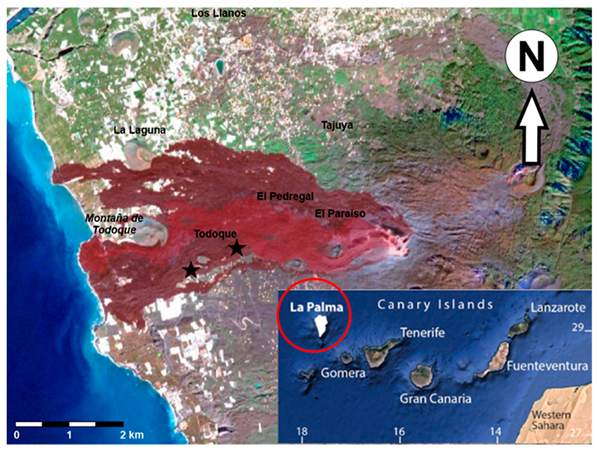
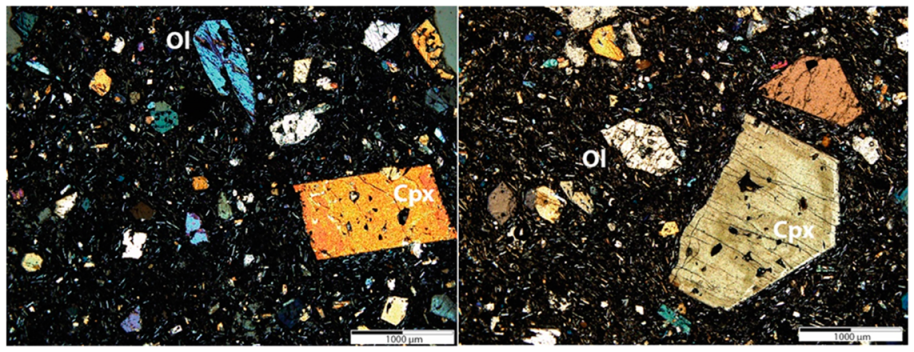

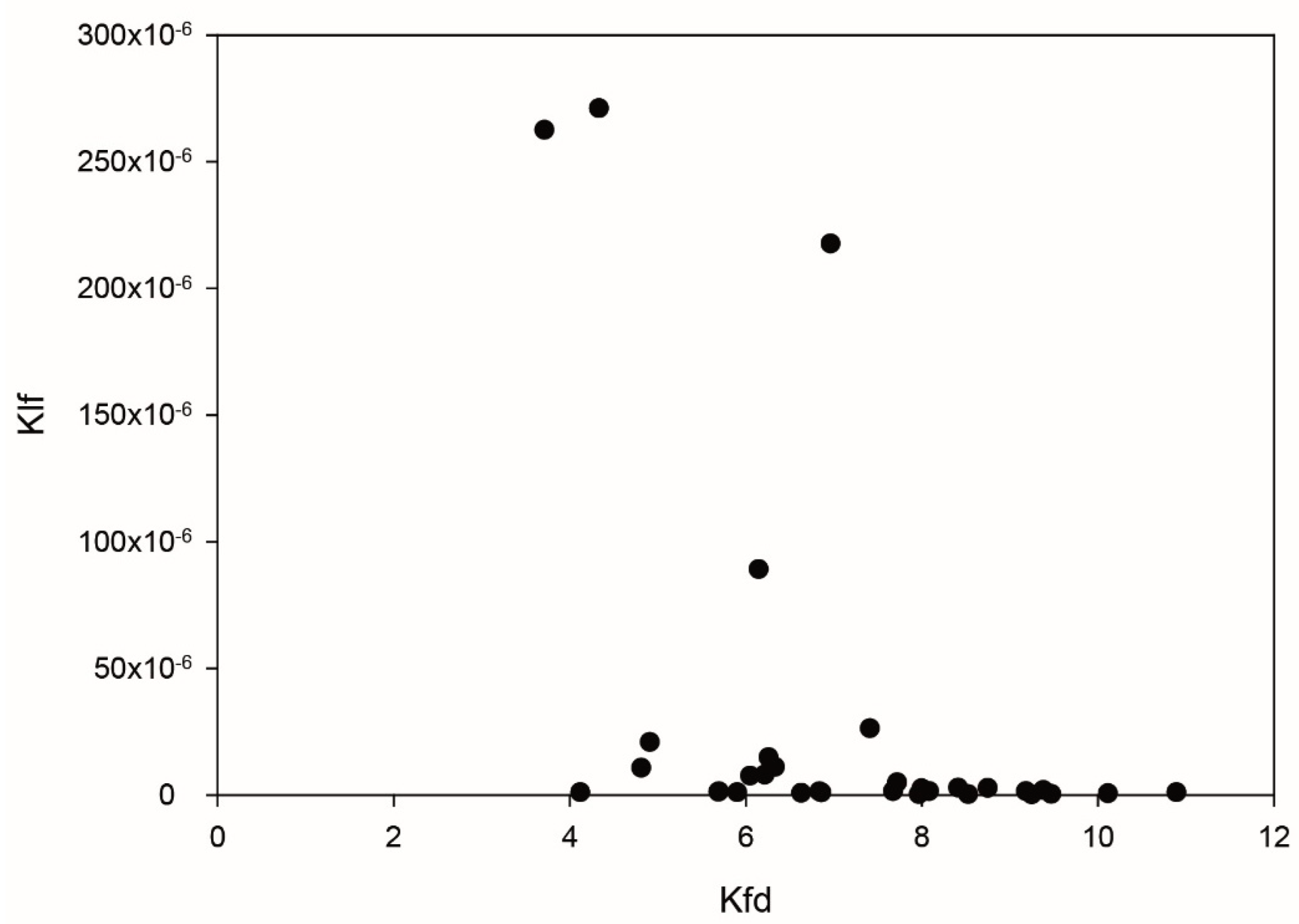
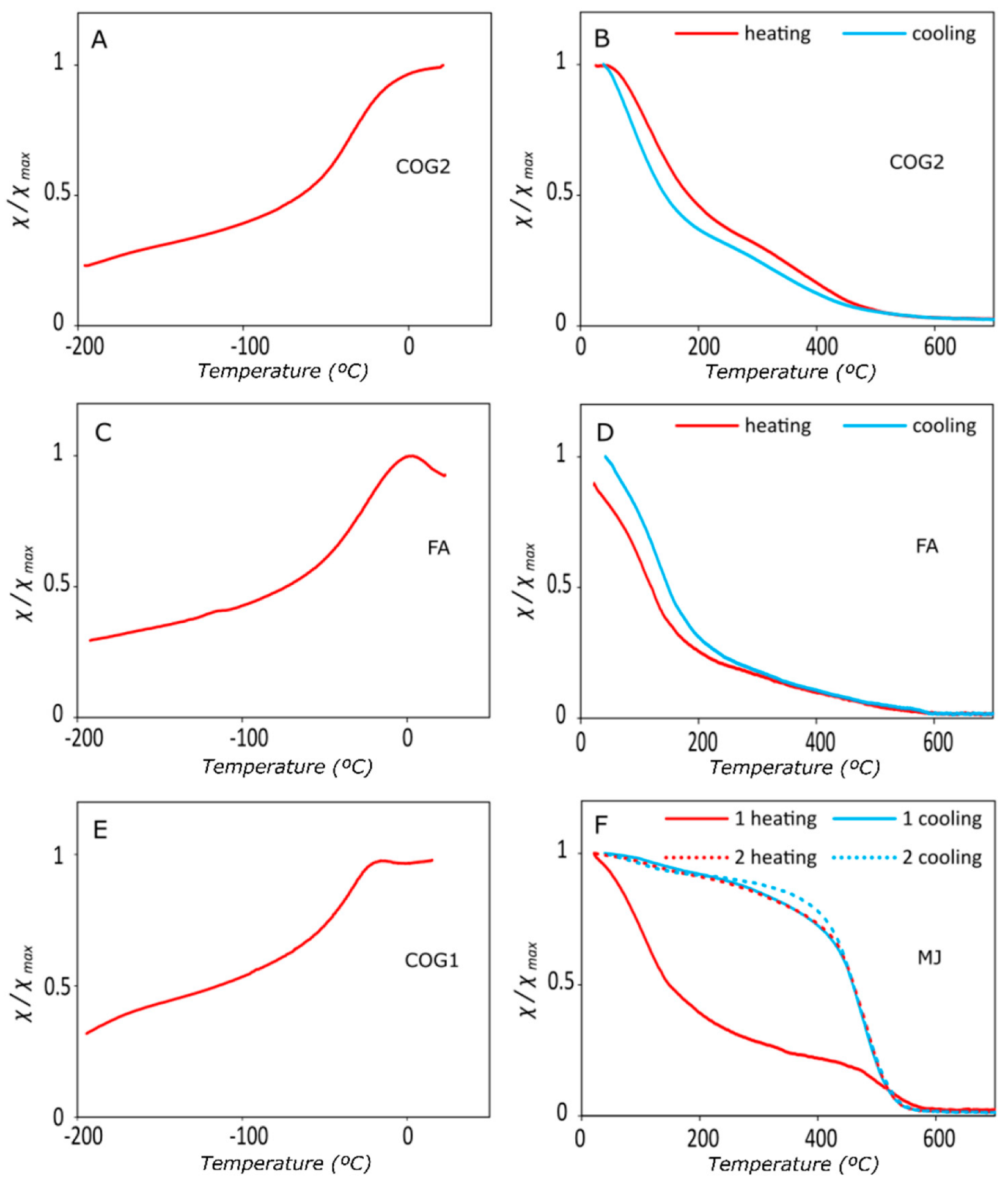
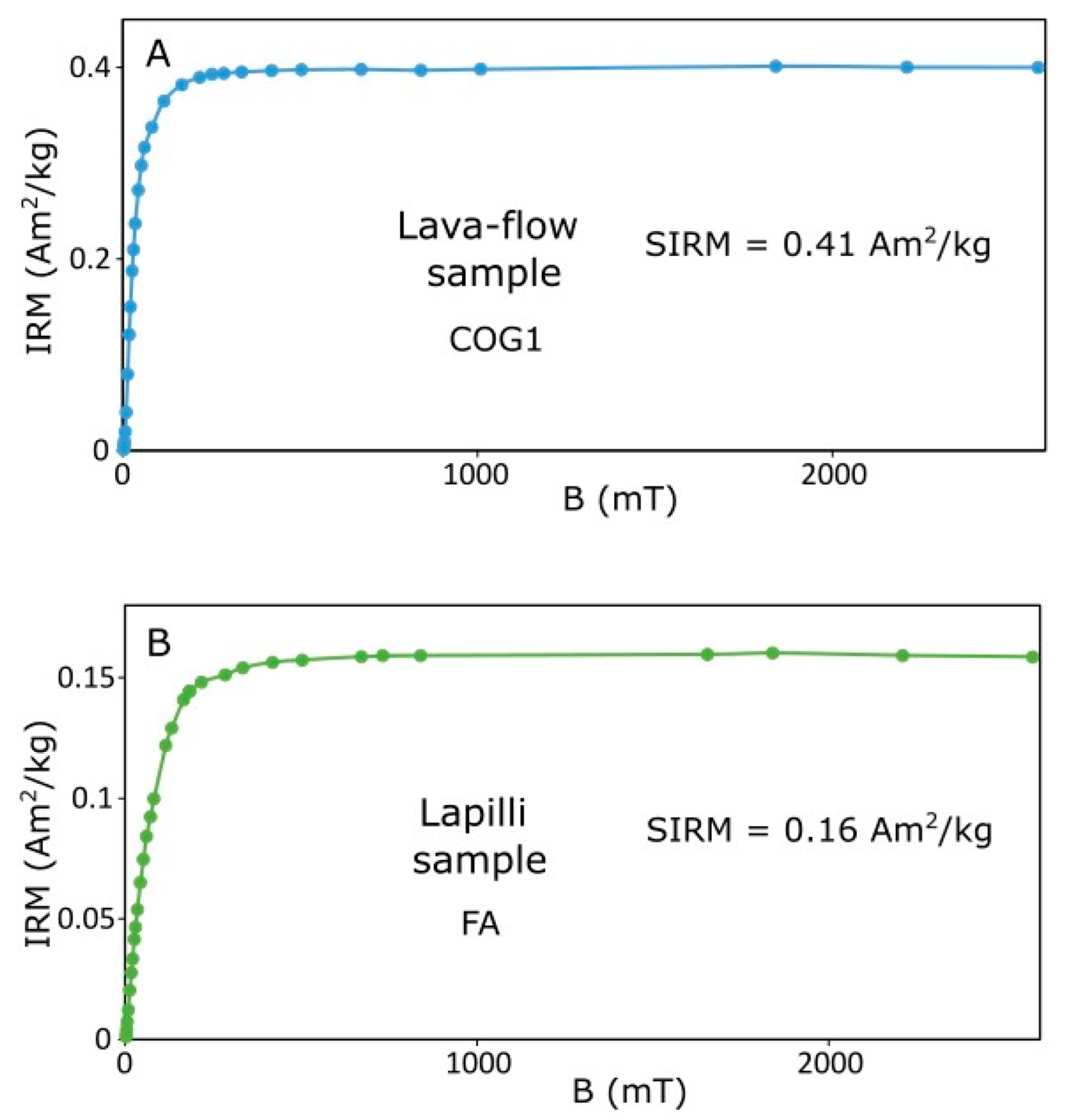
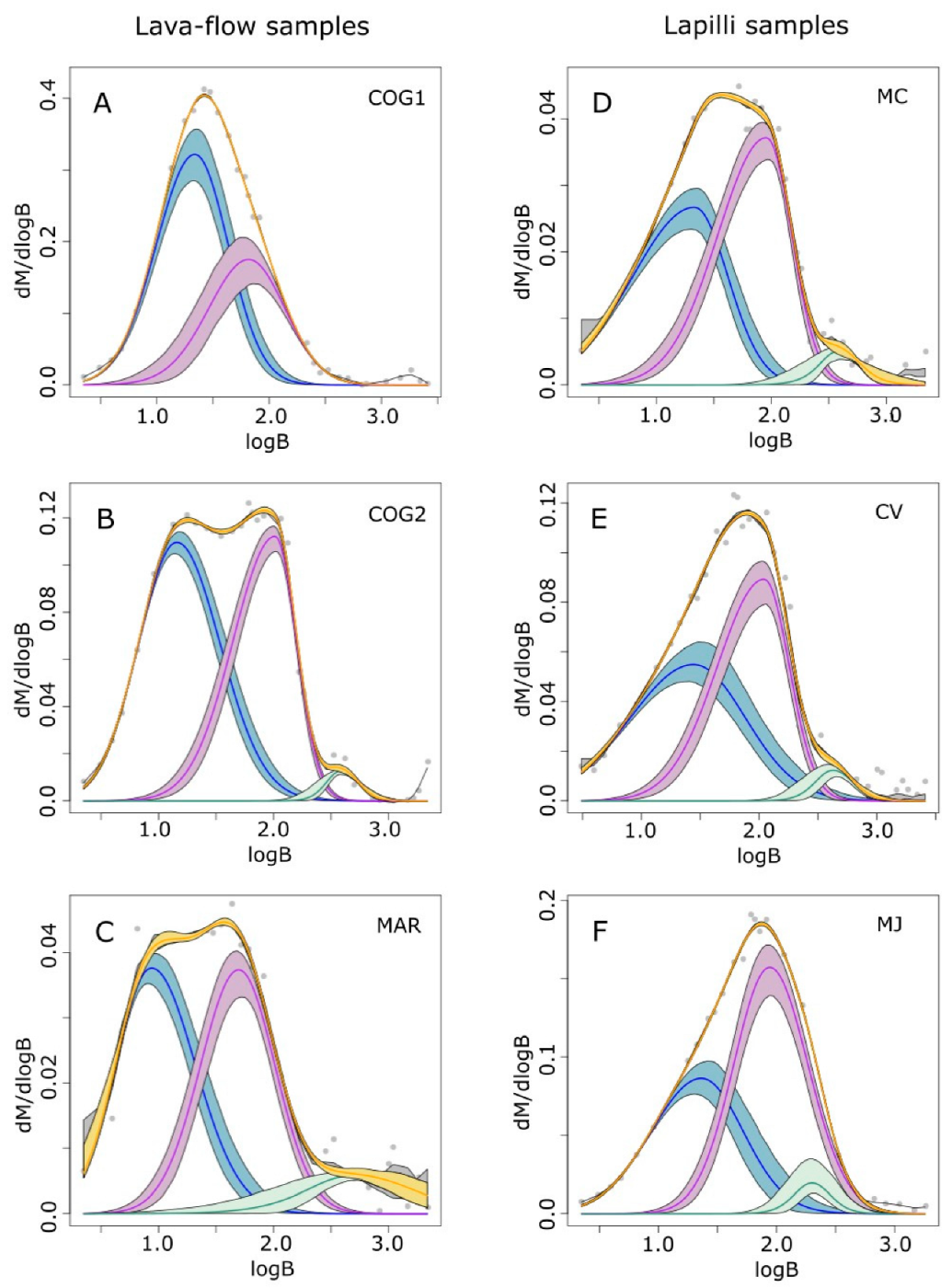
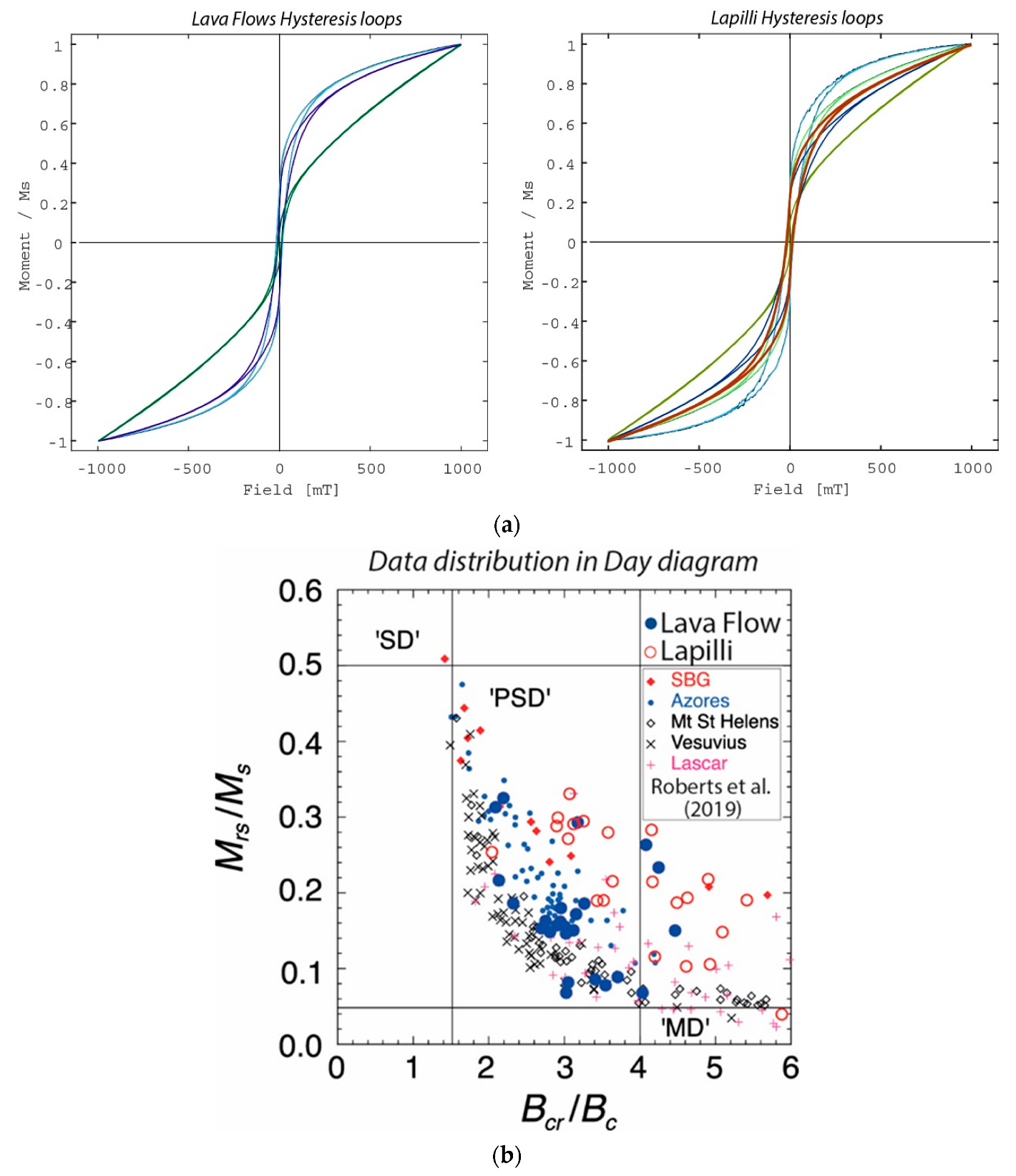

| Location | Samples Code | Sample Type | Latitude (°N) | Longitude (°W) |
|---|---|---|---|---|
| Montaña del Cogote | COG1, COG2 | Lava Flow | 28.61131 | 17.89928 |
| La Mariposa | MAR | Lava Flow | 28.60818 | 17.90714 |
| Montaña del Cogote | MC | Lapilli | 28.61013 | 17.88551 |
| Morro de los judíos | MJ | Lapilli | 28.59070 | 17.90661 |
| Finca el Aljibe | FA | Lapilli | 28.63973 | 17.84939 |
| Cabeza de Vaca | CV | Lapilli | 28.62364 | 17.87100 |
| Sample | Plagioclase | Clinopyroxene | Olivine | Spinel |
|---|---|---|---|---|
| LP-COG2 | xxx | xx | xx | x |
| LP-FA | xx | xx | xx | x |
| LP-MARIP | xxx | xx | xx | x |
| LP-MJ | xx | xx | xx | x |
| Sample | Type | kb (10−6 m3/kg) | kLF (10−6) | kHF (10−6) | MS (10−5 Am2/kg) | MRS (10−6 Am2/kg) | BC (mT) | BCR (mT) | SIRM (Am2/kg) |
|---|---|---|---|---|---|---|---|---|---|
| FA | Lapilli | 3.65 | 0.60 | 0.56 | 1.75 | 3.54 | 11.9 | 53.0 | 0.16 |
| MC | Lapilli | 2.16 | 0.36 | 0.35 | 0.48 | 0.37 | 3.7 | 18.1 | 0.06 |
| CV | Lapilli | 2.27 | 0.42 | 0.42 | 1.29 | 2.76 | 12.1 | 43.0 | 0.14 |
| MJ | Lapilli | 3.45 | 0.29 | 0.30 | 0.61 | 1.84 | 17.6 | 54.9 | 0.21 |
| COG1 | Lava-flow | 6.33 | 42.59 | 56.22 | 5.70 | 12.20 | 10.4 | 25.0 | 0.41 |
| COG2 | Lava-flow | 13.28 | 23.71 | 22.05 | 5.73 | 11.19 | 10.8 | 36.0 | 0.18 |
| MAR | Lava-flow | 8.12 | 3.02 | 2.81 | 5.32 | 5.89 | 4.9 | 15.3 | 0.07 |
| IRM Acquisition | |||||||||||||||||||
|---|---|---|---|---|---|---|---|---|---|---|---|---|---|---|---|---|---|---|---|
| Sample | Component 1 | Component 2 | Component 3 | ||||||||||||||||
| Ref. | Type | Log (B1/2) | B1/2 | DP | S | EC | IRM | Log (B1/2) | B1/2 | DP | S | EC | IRM | Log (B1/2) | B1/2 | DP | S | EC | IRM |
| COG1 | Lava | 1.30 | 20.00 | 0.32 | 0.93 | 0.63 | 260 | 1.79 | 61.58 | 0.34 | 0.95 | 0.37 | 150 | - | - | - | - | - | - |
| FA | Lap. | 1.38 | 24.01 | 0.46 | 0.80 | 0.47 | 76 | 1.90 | 78.80 | 0.28 | 0.68 | 0.46 | 75 | 2.51 | 324.44 | 0.24 | 1.03 | 0.07 | 11.4 |
| MC | Lap. | 1.13 | 13.59 | 0.43 | 0.74 | 0.46 | 275 | 1.80 | 62.34 | 0.33 | 0.72 | 0.50 | 300 | 2.60 | 401.08 | 0.19 | 1.09 | 0.04 | 24.3 |
| CV | Lap. | 1.36 | 23.10 | 0.49 | 0.90 | 0.48 | 66 | 1.90 | 78.52 | 0.31 | 0.73 | 0.49 | 68 | 2.64 | 436.37 | 0.16 | 1.08 | 0.04 | 5.1 |
| MJ | Lap. | 1.31 | 20.32 | 0.39 | 0.91 | 0.39 | 84 | 1.96 | 90.62 | 0.31 | 1.03 | 0.57 | 124 | 2.30 | 200.60 | 0.15 | 1.02 | 0.04 | 7.8 |
| COG2 | Lava | 1.19 | 15.64 | 0.36 | 1.07 | 0.54 | 97 | 1.87 | 74.31 | 0.28 | 0.72 | 0.43 | 77 | 2.60 | 400.53 | 0.14 | 1.08 | 0.03 | 4.6 |
| MAR | Lava | 0.99 | 9.87 | 0.35 | 1.11 | 0.47 | 31 | 1.68 | 48.21 | 0.33 | 0.97 | 0.43 | 29 | 2.77 | 592.47 | 0.48 | 1.12 | 0.10 | 6.7 |
| Parameter | Value |
|---|---|
| Saturating field | 500 mT |
| Hu | ±50 mT |
| Averaging time | 0.15 s |
| Hb1 | −500 mT |
| Hb2 | 500 mT |
| Number of FORCs | 300 |
| Moment Range | 0.5 T |
| Field increment | 1.60 mT |
| Pause at saturating field | 1 s |
| Slew rate limit | 1 T/s |
| HC (min) | 0 T |
| HC (max) | 120 mT |
Publisher’s Note: MDPI stays neutral with regard to jurisdictional claims in published maps and institutional affiliations. |
© 2022 by the authors. Licensee MDPI, Basel, Switzerland. This article is an open access article distributed under the terms and conditions of the Creative Commons Attribution (CC BY) license (https://creativecommons.org/licenses/by/4.0/).
Share and Cite
Parés, J.M.; Vernet, E.; Calvo-Rathert, M.; Soler, V.; Bógalo, M.-F.; Álvaro, A. Rock Magnetism of Lapilli and Lava Flows from Cumbre Vieja Volcano, 2021 Eruption (La Palma, Canary Islands): Initial Reports. Geosciences 2022, 12, 271. https://doi.org/10.3390/geosciences12070271
Parés JM, Vernet E, Calvo-Rathert M, Soler V, Bógalo M-F, Álvaro A. Rock Magnetism of Lapilli and Lava Flows from Cumbre Vieja Volcano, 2021 Eruption (La Palma, Canary Islands): Initial Reports. Geosciences. 2022; 12(7):271. https://doi.org/10.3390/geosciences12070271
Chicago/Turabian StyleParés, Josep M., Eva Vernet, Manuel Calvo-Rathert, Vicente Soler, María-Felicidad Bógalo, and Ana Álvaro. 2022. "Rock Magnetism of Lapilli and Lava Flows from Cumbre Vieja Volcano, 2021 Eruption (La Palma, Canary Islands): Initial Reports" Geosciences 12, no. 7: 271. https://doi.org/10.3390/geosciences12070271
APA StyleParés, J. M., Vernet, E., Calvo-Rathert, M., Soler, V., Bógalo, M.-F., & Álvaro, A. (2022). Rock Magnetism of Lapilli and Lava Flows from Cumbre Vieja Volcano, 2021 Eruption (La Palma, Canary Islands): Initial Reports. Geosciences, 12(7), 271. https://doi.org/10.3390/geosciences12070271






